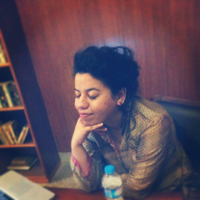More about Deborah Oropallo
Works by Deborah Oropallo

Contributor
Bay Area artist Deborah Oropallo slathers on the layers of meaning, and techniques.
She starts off with your basic digital photographs taken from various sources, fiddles around with them a bit, then transfers them onto paper using a pigment based printmaking process. They are then further coated with materials like encaustic and oil paint to create a very va-va-voom finished product.
Though she's best known for her images that portray ladies dressed up in fabulous costumes ranging from superheroes to fairy tale protagonists, Oropallo also employs her tiered technique to create pictures of humble everyday objects. She's set her attentions on toy guns, train tracks and even plain old rubber gloves.
My personal favorite body of work by Oropallo however, has to be her “Heroine” series from 2012, which phonetically alludes to the word “heroin” as well: drug induced violence is suggested by the bandaged, broken and bloodless bodies that constitute this particular series. There's still something sexy and classy about them though...must be the heroin chic effect.
Featured Content
Here is what Wikipedia says about Deborah Oropallo
Deborah Oropallo (born 1954) is an American artist who is best known for her digital montages. Oropallo produces artworks that conflates symbolic meanings, history and gender. Oropallo lives and works in Berkeley, California.
Background
Oropallo was born and raised in Hackensack, New Jersey. She was heavily inspired from pop arts by prominent artists such as Andy Warhol, Jasper Johns and Robert Rauschenberg since an early age. She studied in Alfred University and got her Bachelor of Fine Arts degree from there; and later received her Masters of Fine Arts from University of California, Berkeley.
Earlier in her career, she mostly produced paintings from already found images, but over the years has evolved to incorporate digital technology. Since 2017, she has collaborated in making video art with Andy Rappaport.
Oropallo's works are held in several museums collections, including the San Francisco Museum of Modern Art, Boise Art Museum, and Stanford University Museum of Art.
Check out the full Wikipedia article about Deborah Oropallo











